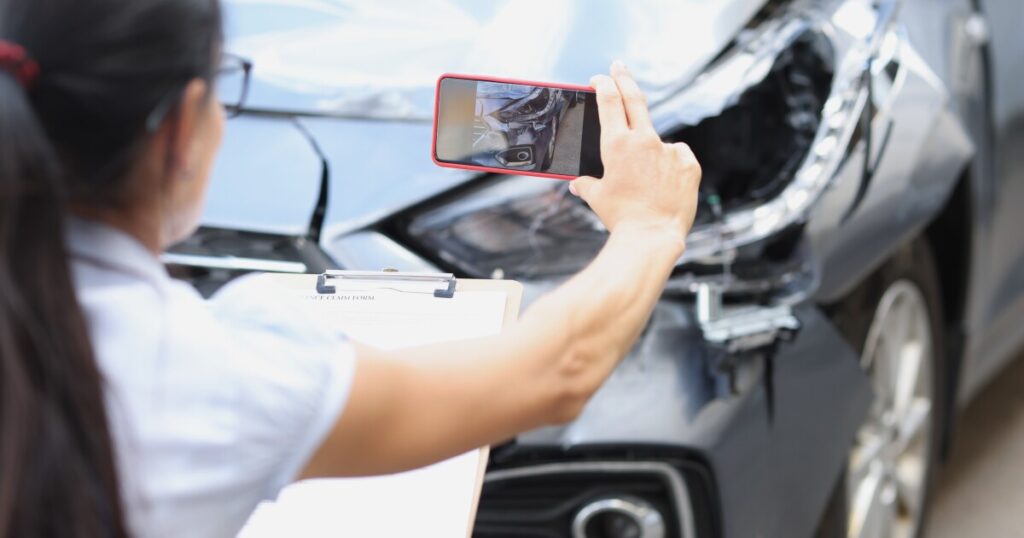Insurers face inflation, rising auto repair costs squeezing margins

The average cost of vehicle repairs is increasing, but that doesn’t necessarily mean that the likelihood of auto insurers declaring total losses after accidents is increasing, according to insurance industry observers and research.
This contrast between repair costs and total loss claims is happening now because of a complex balance of other economic factors in the auto market, says Jason Verlen, vice president of product marketing at CCC Intelligent Solutions Inc., a property and casualty insurance economy cloud platform, which recently published its annual Crash Course report on trends in auto insurance, claims, repairs and driving behaviors.
Jason Verlen, vice president of product marketing, CCC Intelligent Solutions Inc.
“There are a lot of threads here and they’re commingled and not always consistent,” he said, adding that these include decreased auto traffic due to the pandemic – followed by a rebound as the U.S. emerged from the pandemic and working from home decreased – as well as the symbiotic swings in prices for used cars compared to new cars. The increased sophistication and cost of technology installed in vehicles is a factor, but not the only factor, according to Verlen. In addition, inflation also contributed to the increased costs for repairs, which squeezes profitability for insurers, the report noted.
Rising demand for used cars due to supply chain-caused slowdowns in auto production during the pandemic drove up the values of vehicles, Verlen explains. $7,500 worth of damage to a vehicle worth $10,000 meets a 75% threshold used by some insurers. (The threshold can vary depending on the insurer and on insurance regulations that are different in each U.S. state, adding to the complexity). In a tighter used car market, the exact same vehicle might be worth $13,000, so the same damage cost wouldn’t meet the threshold, and would end up being repaired instead of totalling the vehicle.
CCC’s report is based on data collected about more than $100 billion in auto claims transactions it processes through its solutions over the course of the year, serving automakers, insurers, collision repair shops, lenders, parts suppliers and more. From January 2016 through March 2022, the percentage of all claims that were total losses has fluctuated up and down around the 20% mark, but most recently has trended down, dropping below 20%, the report states, as Verlen emphasizes.
More recently, used-car prices have increased again. In the first half of March, according to the Manheim Index measuring prices on a regular basis, wholesale used-vehicle prices rose 1.8% over February’s average.

Ellen Carney, principal analyst, application development and delivery at Forrester Research.
Trends in auto financing could also affect the value of vehicles, in turn affecting the total loss thresholds, according to Ellen Carney, principal analyst, application development and delivery at Forrester Research. “Just in terms of how underwater people are with their car loans, it’s certainly going to have an impact on total loss,” she says. “If you’re underwater on your car, and it’s been totaled, you still have to pay that money to the bank, or the financing companies. It’s more than cost of repairs and wages. We have an auto financing bubble that could burst.”
Against this economic backdrop in the automotive market, the cost of repairs has increased because of technology, but currently does not outweigh the rise in vehicle value. The average auto damage claim rose from about $3,000 five years ago to about $4,000 now, according to Verlen. The reasons for this include costlier replacement parts – especially for computing systems, more complex repair processes, and costlier repair expertise and availability of qualified mechanics.
Auto repairs now require an average of 13 parts, up from 11 previously, Verlen says. More than half of claims now include a diagnostic scan of the vehicle. Replacing a cracked window or windshield used to cost about $100, but with vehicles now equipped with “smart” glass that can sense where vehicles are around you in traffic and issue lane change warnings and more, the cost to replace a broken window is now more like $1,000, Verlen says.
“The average vehicle now has over 1,400 semiconductors in it,” he observes. Electric vehicles double that figure. This contributes to an increased need for auto repair specializing in those computerized elements, which in the industry is paradoxically called “mechanical repair,” according to Verlen. Five years ago, 20% of repairs required this type of work, and now it’s 40%, according to CCC’s research.
“It’s more expensive, and needs somebody who’s comfortable with a computer doing diagnostics, repairing a vehicle and checking that it’s being done correctly. This is computer work,” Verlen says.
Another factor in the increased cost for vehicle repairs is supplemental damage, as Charlie Wendland, head of claims at Branch Insurance, explains. The auto insurance industry’s shift away from sending adjusters to assess damage and toward having insureds send in pictures of damage from their smartphones contributes to this issue, because the photos may not catch everything that has been damaged on the vehicle.
 Charlie Wendland, head of claims at Branch Insurance.
Charlie Wendland, head of claims at Branch Insurance.
Noah Stephens
“Sometimes it would look like a vehicle is repairable because the variation between the repair price and the total loss price is so great,” says Wendland. “But in the supplemental damage process, the body shop realizes during the course of those repairs that there’s additional damage. They go back to the insurance company to say they need X amount more to repair it. After a certain amount of those supplements, it breaches the total loss threshold, making your vehicle a total loss.”
Loaner vehicle rentals and vehicle storage fees also increase the costs as repairs take longer due to the more complex technology, Wendland notes. A labor shortage in the vehicle repair industry is compounding how long the repairs take, as well. Vehicle repair labor wages have been increasing at a greater rate since the start of 2022, according to CCC’s Crash Course report. From the beginning of 2019 to the end of 2021, the increase rate each quarter was around 3% or below. In the first quarter of 2022, the increase jumped to 5%, then above 7% in each of the second, third and fourth quarters of 2022.
“When you have that shortage of talent, you have to pay them more and then that turns around and elevates the cost of labor in these estimates,” Wendland says. “We’re feeling it from every angle, into the backlog that shops are experiencing right now just due to the demand of repairs that are required and the shortage of talent.”
Despite all the new technology in new vehicles, their price is not rising as sharply as the cost to repair them, Verlen of CCC explained. “There is a mass adoption of this technology,” he says. “For automobile manufacturers, it’s economies of scale. That ameliorates the cost to build those things into the car. But for repairs, it makes the cars much more complicated.”
Just as consumers and markets may not have anticipated the increased repair costs and the rise in used-car prices, so have insurers been caught by surprise in their business model for premiums and claims, according to Verlen.
“Insurers have had a very hard time, because they underwrote these vehicles in terms of the premiums they were charging, based on a time where a lot of these forces were not in play,” he says. “They are systematically undercharging customers given the amount of money they have to pay for these repairs.” To address this gap, auto insurers are seeking rate increases or have gotten rate increases from different state insurance regulators, Verlen notes.
One possible way to stop the steep climb in repair costs could be in the auto parts market, says Carney of Forrester. “You’re going to need more replacement parts. Maybe they’re not new parts, maybe they’re used parts, maybe they’re refurbished parts,” she says. “This could drive down repairs and replacement part prices, because of access to more refurbished parts.”



